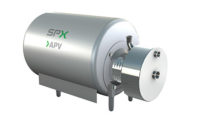
Plate heat exchangers are used for a variety of purposes in dairy processing operations. Some major applications include HTST units (for milk, cheese-milk, ice cream), raw milk receiving coolers, and by-product (yogurt, cream) heater/coolers. Scraped surface heat exchangers are used for large particulate laden products or products which tend to crystallize during processing. There are numerous factors governing the design of a heat exchanger. For instance the product type, flowrate, temperature profile, pressure drop considerations and future expandability requirement are important design criteria when sizing a unit.
Heat Exchanger manufacturers strive for constant improvement in designs to enhance plant productivity. The physical designs of plates have evolved over the years. For fluid milk products, a herringbone or chevron plate pattern will allow the most efficient heat transfer and reduce consumption of utilities such as hot water, chilled water or glycol. More viscous products such as ice-cream mix and yogurt require reduced flow resistance; hence the use of ‘wide-gap’ style plates that allow lower pressure drops and increase CIP response. An expanded inlet design and a wider or “dairy size” gap is preferable for such applications to resist fouling. For very viscous products such as mayonnaise or sweetened condensed milk an expanded inlet design and wide gap/high pressure plate is suitable for heating or cooling.

Typically, for fluid milk products regeneration in the range of 90% was commonly accepted, however today processing plants are looking to upgrade their existing units to 92% or 94%. Even a 1% increase in the amount of regeneration can save tens of thousands of dollars in steam and refrigeration costs annually. Existing units can be upgraded to allow for increased regeneration - the payback time on the capital cost to do this is usually less than 12 to 18 months. Brand new units should be sized for optimum heat recovery to reduce overall operational costs of plants. Manufacturers commonly size units with up to 94% regeneration.
Heat exchangers are the core of any dairy process. It is vital they operate properly with little or no downtime so that production time is not lost. Manufacturers attempt to make the maintenance of heat exchangers as easy as possible. Gasket materials are formulated to be more temperature and chemical resistant to increase service life. The gasket life expectancy is dependent on a number of process variables, including the operating temperature, pressure (or differential pressure), the nature of product being processed and the type and concentration of the cleaning fluids being used. The glue-free (or snap) style also makes maintenance much easier. Frame designs have also vastly improved over the years - dual spindles with self-contained hydraulic closure ensures even closing of large units, saves time and allows easy access for inspection.
One can see it is essential that some type of maintenance program is in effect to keep heat exchangers running without any problems. Heat exchanger manufacturers offer regasketing services - this is often more economical and time saving than performing the same function in-house at the plant. Plate exchange programs are also popular, as the plant is assured that plates supplied are either new or fully reconditioned and hence free from any defects. Some plants opt for a field leak service. This can be performed on site in a few hours keeping the offline time to a minimum. Typically the circulate-dye method is preferred as this type of inspection checks for cleaning response, corrosion and plate wear. All the above methods are classified as preventative maintenance programs and can save a dairy plant thousands of dollars by reducing or eliminating production loss.
